Onam Festival in Kerala- A Complete Guide about Onam Festival
Read this article on onam festival in kerala which gives complete information about Onam Festival 2011.In Kerala Onam is celebrated by people of all castes, creed and religions. Onam is a cultural festival of wearing new dresses, family reunions, songs, dances, games, sports, boat races, pookalam, Maveli pooja, Villu kotal (device like bow and by striking on the string a beautiful sound), sumptuous feast and social gathering etc. Onam falls in the Malayalam month of Chingam (Aug – Sept).
Onam is a cultural and social festival
This year Thiruvonam is on 09-09-2011

Onam will be celebrated wherever there is a Malayalee, in whatever manner possible and practical in the place where he/she is. It is a major part of the Culture of Keraleeyan. In the years by gone people were following a schedule of festive activities for each of the ten days starting from Atham Nakshatram day to Thiruvonam day and a rounding off on Avittam day. Now many of the schedules and activities are compromised or omitted for want of facilities. However the essence of the festival is retained.
During onam, importance is for feast and festive activities. It is celebrated with utmost enthusiasm irrespective community, caste, creed, sect or religion. Since the celebration is to remind us of the prosperous, flawless and truthful period of Maveli (Mahabali), people want to reflect that state during the onam days. People wear new cloths during onam festival. 'Vastra' has the meaning of cloth and also heart. People during that period not only supposed to wear clean clothes but also keep their heart clean by keeping away bad thoughts and feelings. They are supposed to forget the sectarian outlook and celebrate the festival collectively. It is generally a ten to eleven days festival. There is a belief in the minds of the Kerala people that this festival being in the main harvest season of the state, it is like a thanksgiving function to the gods for the great yield in agriculture. According to the stories in Hindu epics, the benevolent king Mahabali visits favorite part of his erstwhile kingdom, kerala once every year during the main harvest season at the same days to bless the people. The festival is all about presenting every one as neat and clean, happy, enthusiastic and jovial; about feasting – traditional Ona Sadhya; family reunion; social gatherings and social exposure of art talents etc.
Normal Rituals
Nine day Schedule
As mentioned earlier, there used to be a schedule of activities to be performed from 1st day to the last of the festival. Now this activity starts mostly from Atham day (1st day of Onam). From Atham day till Moolam day there used to be 2 mud forms (matheri – mathevar). This is still followed in many places. The number will increase to 3, 5, 7 & 9 from Moolam to Thiruvonam. On Uthradam day evening there will be additional mud forms added representing various connected mythical figures mentioned later. Another item was the willu kotal mostly by children. Even elders used to use this. But now this is almost an extinct item and most probably most of the people may not even know what willu kotal is. Many of the other items are condensed or merged together to suit the circumstances prevalent as of now.
The First Phase of Onam
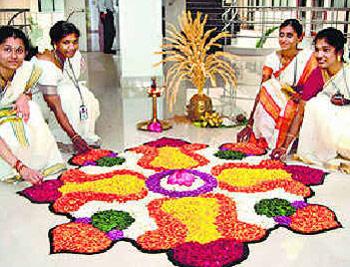
Onam festival is normally supposed to start from the 1st day of Chinga masam to the Avittam day i.e. almost till the end of the month. For the first few days from the Chingam 1st to the Atham day, every house in Kerala pookalam (rangoli or kolam like designs with flowers/petals) will be made in front of the house. The design and colour pattern will change every day. The size will increase by on layer every day. This item of the function is almost stopped all over the state, may be due to the preoccupation of people, non availability of flowers in their houses, exorbitant cost of flowers in market etc. Normally this used to be done by the children of the house and their friends under the guidance of the elders. This used to be mostly with the flowers available from the house compound and around. Often there used to be competitions between the neighboring houses in making the Pookkalams. Now in most places the Pookkalam phase is not practiced and any onam activity starts only from Atham day.
The Second Phase of Onam

The 2nd phase of onam, slightly more in rituals than the Pookkalam phase, starts from the star day of Atham, usually considered as the start of onam. From Atham star day there used to be two muddy rectangular pyramidal form (called the matheri or mathevar in colloquial language in central Kerala) of about 1 to 1 ½ foot height with a base measure of about 3" square. The top will be around ½ to 1 inches square. The base of the muddy form will be placed in the middle of the Pookkalam (flower decoration). On the top of the mud form there will be flowers tucked. Mornings and evenings oil lamp will be kept if it does not rain. If it rains the lamp will be shown in this place and kept in a shady place. In most houses there will be some offerings of sweet, like payasam. From this day there will be Maveli (Mahabali) Pooja. The pappadam (an item made from udid - urud dal powder and some other ingredients, round shaped which will be deep fried in oil and will become like big wafers with a wonderful taste) and 1 or 2 extra vegetables will be added for the meals from this day with a sweet made at home generally a payasam and Nenthra Pazha nurukku (Nenthra means a special type of banana the biggest variety in banana, used to be cultivated only in Kerala in India earlier; Pazham means banana; and nurukku means pieced – the whole 3 words meaning 2 or 3 pieced banana boiled cooked with jaggery and water) . During this period the tenants of land, workers and other friend etc will be bringing items like Nenthra banana, vegetables, plantain leaves, flowers, fruits etc to the houses of superiors in social status as gift (Kazcha kula).The Third Phase of Onam
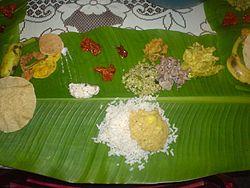
This starts from the star day of Moolam (Moola). From the day the number of the muddy pyramidal forms will be 3, 5, 7 and 9. On Uthradam and Thiruvonam star days, in addition to the normal forms there will be additional muddy forms prepared according to the imaginations and ability of the persons in the house or the helpers. It will include, forms by names Sri Krishnan, Pandavas, oil man, muthassi (old lady) etc.etc. By this time those who come for reunion will be arriving in the family. From this time the number of vegetable dishes will increase with the additions of raw banana wafers, Sarkara Upperi (Jaggeried banana pieces - wafers) etc. On the main day of the onam (Thiruvonam) the feast will include Parippu, Pachadi, kootu kari, Kalan, Elan, Avial, Erisseri, Moru koottan (more kozhambu), Sambar, Rasam (a kind of watery soup with masala) 2-3 cooked vegetable curries (neither with liquid or gravy nor fully dry) and one or more Mezhukku puratti – dry fried vegetables (normally yam pieces, raw banana pieces etc cooked, shallow fried with very little oil), pappadam (2 sizes – large and small), banana wafer (kaya varathathu), Sarkara Upperi, paal payasam (porridge with milk or coconut extract and sugar) and optionally curd (Yogurt – thairu). Since few years these items are reduced and there may be some items introduced from other state culinary. There will be matching breakfast and dinner which may lighter. Thiruvonam day
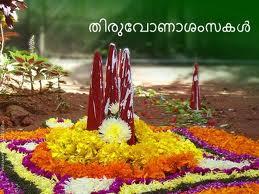
On the Thiruvonam day for all the family members, new dresses will be given in the morning itself by the head of family so that they can wear the same immediately on taking bath. All persons working for the family like the family relations, workers, friends and other important connected persons and officials of Panchayath, village office etc will be invited for food and after the food, they will be given a dress set; for men mundu (white lungi) and either a neriyath (special towel) or shirt piece and for ladies either mundum neriyathum or sari and blouse piece and an amount of money (all these items depending on the status and position in the society). For family members, depending on age the dresses will be given in the morning itself so that they can wear the same morning itself on taking bath. General Rituals of the Onam Festival
Ona pudava
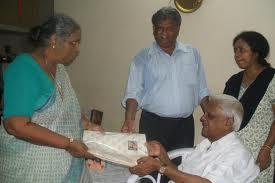
New Dresses are one of the important item of onam. In the earlier period, houses used to buy new dresses only on the occasions of Onam, Vishu and Thiruvathira for the whole year. Now this is changed. Dresses will be bought as and when required. However, even now for onam at least a new set of dress will be bought for every member of the family and other important guests. Earlier it used to be Kasavu (golden zari) mundu and anga vastram (Mel mundu) for elder male members, Onnarayum mundum neriyathum for ladies and new small size Kasavu mundu and shirt for children. There used to be very many varieties for different status of people.
Songs and Dances mainly for Ladies and girls
The ladies and girls will be in new and gorgeous traditional dresses (generally in mundu and neriyath), bedecked with jewelry having fragrant jasmine flowers in the hair – beauty at its best. They will be moving in graceful manner giving a feast to the eyes of the beholders. Some of the items are as under: Onam Songs
Special onam songs will be rendered individually and by groups. There will be singing competitions by individuals and groups. Within this category there will be Akshara Slalom competitions by groups. In Akshara Slokam one team sings a couplet or 4 lines of a song. The other team is to pick up the last letter and start the couplet or 4 liners and son. This can be folk songs, classical music or film songs or all mixed together. Pookkalam (flower arrangements)
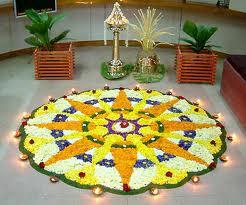
This is a competitive game where ladies groups make designs with flowers like the rangoli or kolam. In this competition we can see very intricate and complex designs both traditional and modern themes. These groups will include girls also. Thumbi Thullal
Thumbi thullal is a fold dance by ladies. The ladies and girls of all ages will sit in circle and one – the leader will sit in the center of the circle. The leader sing couplet and the rest sing the same in chorus. All of them will sway their body and hands rhythmically to the tune of the music resembling the flying of the dragon flies. Thumbi means dragon fly. May be because of the movements of the hand body this is compared to the dragon fly movements. Or it is possible that since the ladies will be holding the Thumb branches (a small grassy medicinal plant with white coloured small flowers) and the same will shake with the hand movements of the ladies in this program it is called thumba dance changed into thumbi thullal. Kaikotti Kali
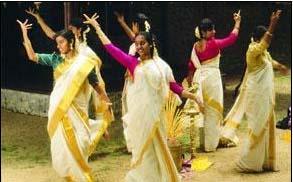
This is also a folk dance by ladies where the pattern of movement and clapping of palms will be rhythmic in tune with the music. The patterns of movements of the ladies will be graceful beautiful like a weaving in out creating an imaginary pattern. Kolaatam Kali

This is also like the previous dances. The difference being that the ladies will be holding one stick each in both hands and will hit together their own sticks and with the sticks of the neighbors in rhythmic way. The hitting of the sticks will make sound like an accompaniment c for the music, which will be rhythmic and pleasant. Villu Kotal (making sound from a bow like instrument)
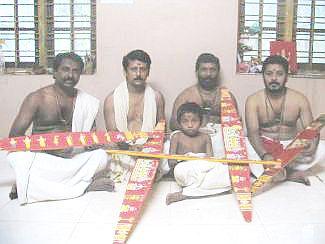
This item is almost extinct in almost all over Kerala. But this was a very important activity followed in every house where there is at least one child above 4 years age. As mentioned this is making sound on an instrument like a bow. The bow is made of palm/coconut tree stem piece of about 2 to 4 feet in length and 3 inches wide at the center and about 1 to 1 ½ inches at the both ends, gradually tapering on either side from the center. The 2 ends will have a groove. There will be a piece of thin bamboo stick about 1 to 2 inches short in length than bow stem, with a provision to interlock the ends with the grooves of the bow stem by bending the stem with a little force. When the bamboo stick like thing is interlocked with the stem, the whole thing will look like a bow. Since it is tense if the bamboo stick portion is beaten with a stick, it will produce a sound almost like that of the Thayamabaka chenda sound. Children, even elders used to play this to make sound like Thayamabaka or Melam in competitive spirit. Games and Sports for Men
Panthu Kali (bat & ball game)
This is a game which is similar to a crude form of cricket game. There will only be one wicket (one stick fixed to the ground). The ball is prepared by covering few pebbles by dry plantain leaf pieces or coconut tree leaves or palm leaf pieces in many layers and tied properly so that the leaf pieces/leaves do not fall apart while playing. Like in cricket there will be 2 teams. The play will be within a court drawn by stick or marked by lime powder roughly on the ground. The bat is a stick. One person from one team holds the bat and hit and deflects the ball which is thrown against the wicket. One from the opposite teams throws the ball against the wicket. Other members of this team try to catch the deflected ball. Either if the ball hits the wicket or the deflected ball is caught after hitting the same by the man with the bat (stick), that player is out. In this game there is no age bar. Kayyankali (Combat)
This game as the name suggests is a fight between two combatants. They fight with the hands and body. No weapon is used. But the game is a show of strength between the combatants. Since it is a very rough game with use of maximum physical strength to prove the power of the players, there will be some violence, injury, accident or occasionally even death. This game is almost extinct.Attakalam (like Chadugudu)
This game is played in two groups instead of individuals. There will be a circle drawn in the ground. One team will be inside the circle and the other will be outside. One member of the outside team goes inside the circle and tries to drag one inside member out of the ring. Both sides use force in the play. Once a person is brought outside the ring, another person is tried till all the members of the team are brought out. Similarly if the outside who went inside is caught and prevented from going out of the circle for a specified time limit, that person will be out. The one who come out is considered as out of that game. If all the members of the inner team are brought out, they go to outside and the other team comes inside the ring. If all members are not brought out from the circle, then the players inside the circle are declared as winners. Onathallu
Onathallu is a game like a colloquial form of Kalari exercise. This is found only in selected places as it requires some skill in wrestling like activities. This activity is not very widely practiced. Ambeyyal (Arrow shooting – archery
This game is played between two groups. Both side players will have bows made of bamboo sticks of 18 inches or more in length and both end tied with a strong string to make it like a bow. Blunted sticks are used as arrows. Each tires to shoot the arrow across to a small wood piece, used as a mark, which is kept in the middle. Those who hit the stick can collect all the arrows falling around the mark. Those who exhaust the arrows are out of the game until only one is left who is the winner. In this game there may be some stray cases of injury. Kootu kootu (a form of Kabbadi)
In this there a rectangular field is drawn which is marked into 2 halves with a line in the center. Two teams of 8 members each are place in each part. From one group a person goes to the other group and tries to touch a person there and tried to go back to his group. If the man touches any one from the other group and crosses the middle line to his group the man touched from the other group is out. If in the process, the man trying to touch is caught and he cannot cross the middle line within a time limit, he is out. This game goes one til all members of one team are out. This is like Attakalam game. Pakida Kali
In this game a square is made into many smaller squares like a chess board without any colour scheme. Mostly it will be drawn in the mud ground itself. Two pawns will be used for two different persons one from each team. There will be two metal oval shaped balls (called the pakida – like the plastic cues of the snake and ladder and other games) with marking of 1 to 6 dots in each of the pakidas. One man throws the pakidas. The total markings on the upper side of the pakidas when thrown are added up and that is the number of points the man gets. He can move his pawn up the squares to the extent of the points he earned. If his points 8 or 12 he gets again a chance. Otherwise the other man plays and he moves his pawn as per the points he get. The game will be over when one completes all the squares and declared as the winner. While moving the pawns, if one of the player's pawns gets into the same square of the previous player's pawn, then the previous player's pawn is kept back at the start. This has almost become extinct.
There are some other similar games, card games etc. Pulikkali or Kaduva Kali

This was an original play found only in Thrissur town in the earlier years and later spread to Thrissur and Palakkad districts. Now it is spread throughout Kerala and even in some neighboring states. In this men and boys dress up like tigers, bears and lions, deers etc and move in the form of dancing with stopping for playing like the tiger hunting for preys and imitating of attacking of the bystanders. Kummatti Kali

In this the persons participating will be heavily dressed with wooden masks brightly painted playing the mythical characters and plays. The dresses and masks will be like that of Narada, Krishna, Radha, Darika,Kaliyan and hunters etc. It will be like the traditional dance drama or a crude form of ballet. Vallam Kali
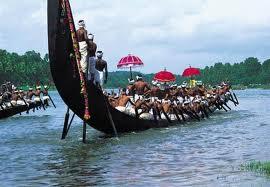
Vallam kali is boat races. Boats of all types like the normal one and the snake shaped long boats etc race in backwaters in Ernakulam and Alapuzha districts. This is probably connected with the legend of the Palliodam episode where the boat which could not negotiate a gorge in the river could easily cross after feeding a poor widow with a child. As a reminder of this incident every year boat races are done. It starts from the Uthradam day at Aranmula and goes on for many days in different parts of the Kaayals (back waters) of central and South Kerala. The main race is the Nehru Trophy race. This does not coincide with the onam always, because it is fixed on 2nd Saturday in August every year. This year it is on 13th August. Onam celebration in various parts of India
Onam is synonymous with Kerala and Malayalees. Where there is Malayalee there is Onam celebration during onam days. However, since there are cultural differences between that of Kerala and other parts of the country and abroad, Onam cannot be celebrated as it is celebrated in Kerala. In kerala there will be state holidays during onam days where as in other parts of the country there will be no holidays. Hence it may not be possible to celebrate as a social function on the Onam days itself.
For the above reason onam will be celebrated on holidays or Sundays at other states according to conveniences of the majority of the Malayalee community in the respective centers of the states. Hence it may be held on different days at different centers of different states. Normally it will be a one day function.
All people assemble for the day in the morning mostly after breakfast. In some cases the assembly will commence with breakfast. During lunch time there will be the traditional feast prepared by Kerala cooks for those who have assembled. Most of the items found in Kerala celebrations will be found in these preparations. In some places night dinner also may be arranged but in a simple way.
There will be games which are practical in the assembled places. There will be Pookkalam competition mainly by ladies watched and commented by the male members. The other games will mostly be indoor games like the singing competition, Akshara Sloka, Card games, Kai Kotti kali, kolaatam, Kummi etc.
Most of the participants will try to wear the traditional dresses except in some places like parts of Mumbai where there is some antagonism against outsiders from the local people. But in Southern states it is almost like Kerala celebrations for one day.
In Bengaluru and Chennai in South and Mumbai, Jamshedpur, Bhilai, Ranchi, Rourkela and Delhi in North there will be several places where Onam is celebrated as there is a large population of Malayalees in these places. In other places and abroad the celebration may be in one center each. Onam Attractions
Every state in India has its own main festival of the year which is celebrated in a pompous way by the locals as per their respective traditions. Even where there are some common festivals like the Ganesha (Vinayaka) Chathurthi, Aayudha Pooja and Deepavali, Ramanavami, Janmashtami etc which are celebrated in most states of the country the celebrations vary according to the states' customs and traditions. Other than the above festivals, each state will have its own festival which is a major one for that state. For Kerala Onam is the biggest social and cultural annual Festival. It is a unique festival of Kerala. The Sravana (Chingam) Masa Mahavishnu and even Mahabali chakravarthi are very important for many states in India; Many Vaishnava temples all over India will have special functions on the Thiruvonam day as it happens to be the Jayanthi day of some of the incarnations of Mahavishnu. However, Onam is a festival only for Kerala. Onassadya
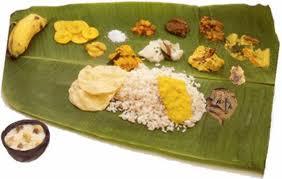
For onam the main attraction is the onassadya (onam feast). There is an old say "Kaanam Vitus onam unnanam". The meaning is one should eat on the onam day even by selling the land, if necessary. That shows the importance the older generations attached to the feast of onam. The main fest is of the lunch of Thiruvonam day. The onassadya consist of about a minimum of 3 courses to 11 courses depending on the financial and health status of the family and members. The courses will normally be from the kalan rice, moru koottan rice, sambar rice, lemon rice, tamarind rice (puliogere), rasam rice, payasam (2 or more verities like milk, jaggery, chakka (Jack fruit)/pazham (Nenthra banana) prathaman and curd rice etc. In addition to the above items concerned, pazha nurukku, another sweet dish, pappadam, banana wafer, sarkara Upperi, Mezhukku puratti (2 or 3) and 2to 4 vegetable curries (thorans). The onassadyas on other days will be a less elaborate one. Ona Pudava

A very important attraction of onam is the ona pudava that is the new dresses. Dresses for all the family members from the smallest child to the eldest person in the family will be bought in advance. On the Thiruvonam day after taking bath and applying sandal paste on forehead with a visit to the nearest temple, each member will go to the head of the family. The head of the family will give a set of new dress to each of the member of the family. In the olden days there used to be types of dresses for the specified age groups. Usually the dresses will be bought sufficiently in advance so that those dresses which are to be stitched can be stitched in time to wear on Thiruvonam day. In the bye gone days the practice used to be buy dresses and all other house hold necessities for the whole year during on 3 occasions only that is before the onam, Vishu and Thiruvathira. Now the practice has changed and things are bought as and when required. But for onam new dresses of at least one set for each member wail be bought. The main purchases will be of course for the onam. After the Uthradam star day the shops will be closed for 3 - 4 days. Family Reunion

In the olden days members of the families wherever they may be will come to take part in the onam festival in the family with every member of the family. Now due to practical difficulties like the work pressure, school/college vacation timing, and non availability of rail tickets etc the reunion is not very prevalent in many families. All people will celebrate in their respective places ad greet the family members. Games/Sports
This is the next attraction. Groups of the persons from the nearby families will come together in a particular house or place and most of them will participate in these events. The main events for men and boys are panthu kali, Chadugudu, pakida, Kayyankali, Ambeyyal, Attakalam etc and for ladies it will be kai kotti kali, kolaatam, kummi, singing competition etc. Akshara slokams will be there for both groups.
For the entire public of the locality common games like Pulikkali, kummatti dance and wherever applicable boat races etc will be arranged at some central place.
In many places there will be chozhi kali. Young persons will cover themselves with dried plantain leaves and go from house to house singing and dancing.
Then in most places there will be procession of a group of persons with one 'onathappan' and followers who will move around main thorough fare of the place shouting slogans and telling stories.














